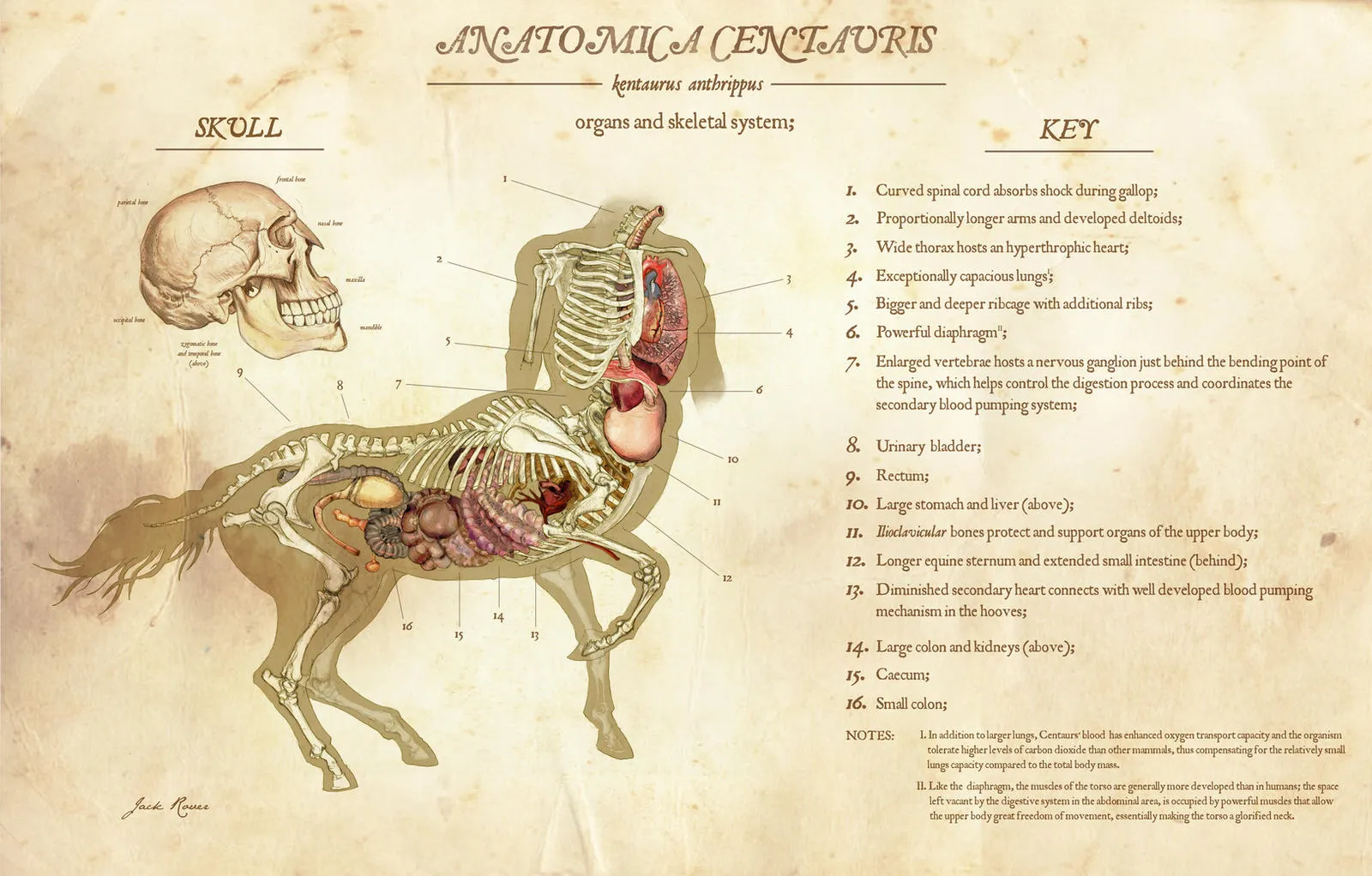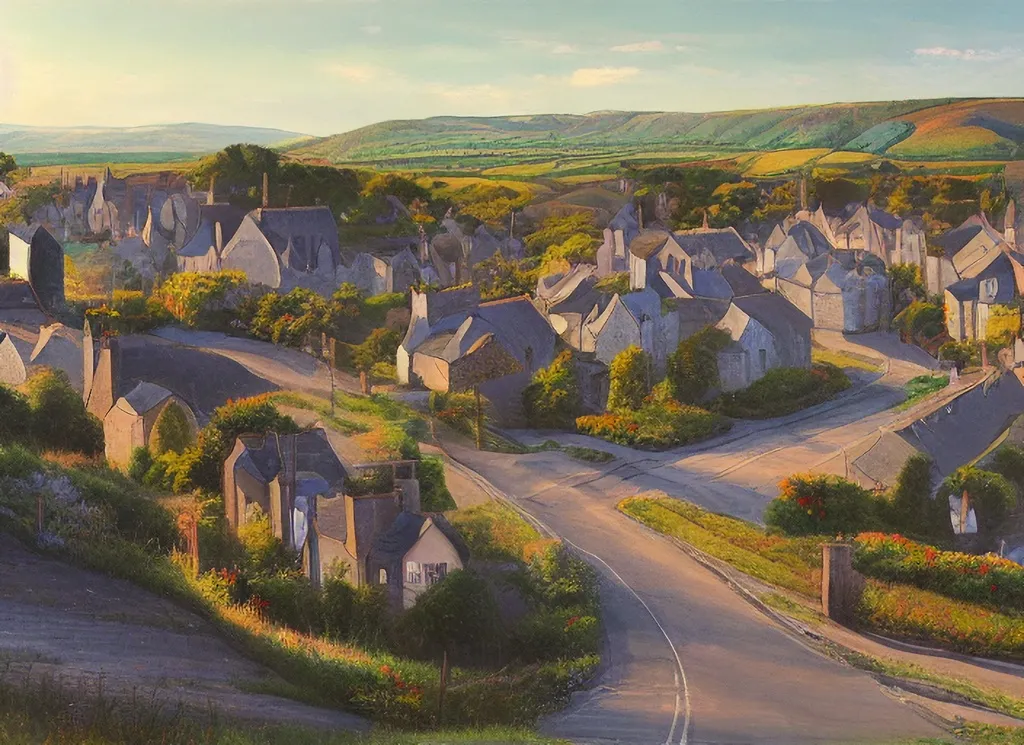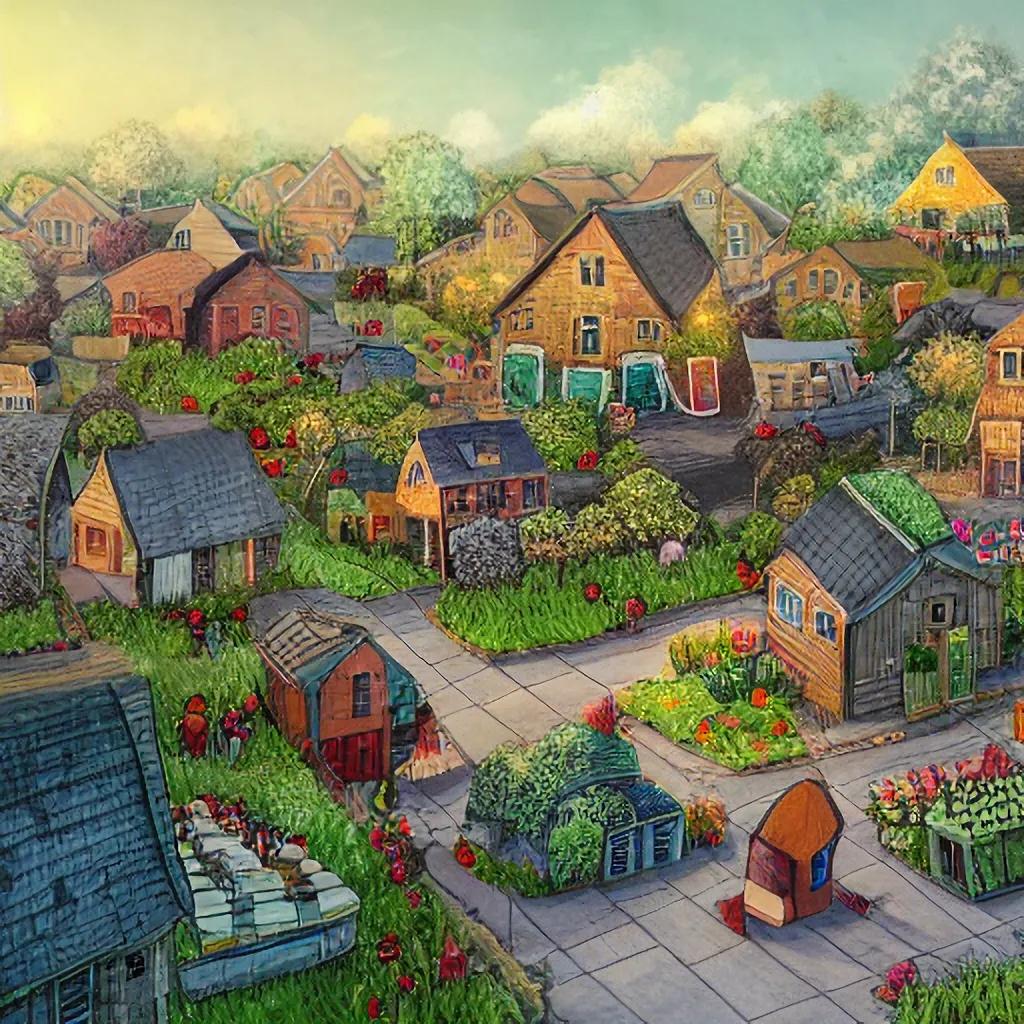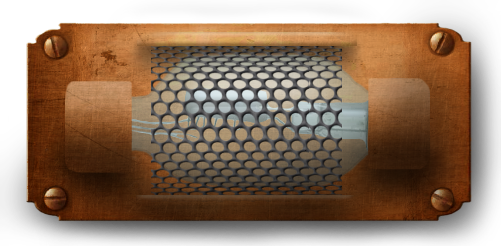The Tauric Peoples are human in origin. Unlike many humanoid species, Taurs came directly from humans. Unlike Imperials, who are descended from the Thirteenth Tribe, Taurs are descended from the other Twelve who remained in Eyom.
Like all humans who remained in Eyom, the Taurs were subjected to the Beastblood Curse by the Archdruid He-Who-Walks-Among-The-Trees. The Beastblood Curse is one of the two curses placed upon the humans of Eyom in the early days of history. Specifically, it is the one responsible for instilling the abilities of the animal world upon humanity at the cost of warping their forms in unpleasant, unsightly, and often painful ways.
In the centuries since the infliction of the curse, humanity has done its best through natural selection and family planning to alleviate the marring of their forms. Modern Sylvian and Tauric humans have gained grace, beauty, and elegance in the form and function of their bodies and have fully adapted to civilized life with no two people appearing to be the same species. Such harmony is only possible due to the passing of a great many years.
In the early days of the curse, the Sylvian kings intentionally othered any human who mutated in such a way as to grow the lower body of an animal in place of their legs. This was used to culturally unify the vast majority of humans around a common foe they could see and combat as the druids remained out of reach. The Taurs responded most sensibly via a mass exodus from Sylvian lands. They found their home in the south-central planes, hills, and coasts of Eyom, where they thrived, forming many nations.
Scholar's Note: The Tauric Peoples are afflicted with both the Beastblood and the Genus Iniuriam curses as they were still close enough to Sylvians to be affected by the blood magic which caused the Genus Iniuriam. However in the centuries since then, Taurs have become a distinct species of their own. The separation passes the strict scientific test of reproduction compatibility as Taurs are unable to reproduce with Sylvians. However, Taurs are still human as they are able to reproduce with Imperial citizens.
Given the quite low Imperial-Sylvian couple's fertility rates, and the remarkably high Imperial-Tauric fertility rates, it is possible that Taurs are less mutated than Sylvians
Personality
Like all humans, Tauric folk are quite varied in their general behaviors. With most people, a general trend of behaviors can be found through careful and close observation. This is true of humans but to a much less degree. Humans are agents of chaos, change, selfishness, greed, and also altruism, great compassion, unwavering faith, and endless hope. These factors combine to produce a species that is bipolar by the standards of any other species.
With all due respect to humanity, the following can be said to be its core, the set of behaviors around which any human species' individual members form their personalities. The raw iron which the forge of birth and hammer of parentage will forge into a finely honed blade upon the anvil of life's experiences.
Humans have an intrinsic need to be a part of a group, preferably a large community. This need is compounded by their desire to be highly respected within the affirmation community if they cannot be the most revered within it. Consequently, humans constantly make small communities within larger communities and seek out new communities. This is both a form of self-gratification and a deep seeded belief that if they had power, they could make life better for everyone.
Humans inherently want to make their own standing in the world better, and there is no better way to do this in their eyes than to be the one in charge of their tribe. Regardless of what a human does, they do it because they believe it will ultimately help others. At their core, no matter how misguided, no matter how uneducated, or misinformed, regardless of their specific beliefs, a human does what they do under the belief that ultimately it will help others or put them in a position to help others.
Even here there is great variance, specifically in the number of people a human seeks to help. They may seek only to help themselves, or their families, or town, nation, or even everyone. There is no means by which one can know this aspect of a human without learning it first hand on an individual basis.
More than this cannot be said. Humanity may have instinctual behaviors like the majority of species, but such instincts are burned away by the socioeconomic circumstances of their birthplace and time. To know what a human is like is to know what their cultures are like.
The Tauric Peoples hold true to this standard, with a few small adjustments owing to the substantial differences in biology from bipedal humans.
Taurs despise small spaces and will modify their environments to ensure there is sufficient room for them to turn even if this means leveling a small hill to make a home with sufficiently wide halls and spacious rooms. Their fully omnivorous nature and extremely high caloric requirements due to their general body mass means Taurs have no issues with consuming anything plant, animal, or person.
While not strictly speaking cannibals as they feel no particular compulsion to consume the flesh of thinking creatures, Taurs suffer no disgust should they happen to have consumed some, nor will they turn it down if it is presented. This behavior is almost assuredly due to their eating needs and habits, which result in them consuming 1-2 dozen kilocalories every 3-4 days. This is true even of those based on herbivorous animals.
Taurs generally speaking, do not like wearing clothing on their lower bodies. The vast majority of them report it feels constrictive and makes them believe something is grabbing at them. Equine based Taurs often kick in these circumstances, suggesting there is a biological reason behind the discomfort. They experience no discomfort from saddlebags, or other elements of tack upon their lower backs, the unpleasant sensations are limited expressly to the hindquarters. An exploratory autopsy of the nervous system within the area would doubtlessly yield an explanation, but no Tauric family has yet volunteered a corpse for the necessary scientific operations.
Standing Offer for Tauric People from the Royal Academy of Medical Science: Any Taur who donates their body to science will get their family a bounty of six bars of gold, each weighing one stone and none being less than 99.98% purity as compensation. YOur remains will be examined strictly for the advancement of medical science, and may yield a cure or treatment for the general discomfort caused by light pressure on your kin's hindquarters. Your people's traditions will be respected in regards to your remains. Your body will be returned to your kin after the operation is over as whole as our surgeons can make it, with all fluids present. We would not ask you to forsake your people's burial practices for the advancement of science.
Physical Description
 The Tauric Folk are quite varied in appearance, as are all human species native to Eyom. This goes beyond the mere differences in skin pigmentation known to Imperial citizens. Eyom's humans were afflicted by a flesh-changing curse nearly two thousand years ago at the very dawn of recorded history.
The Tauric Folk are quite varied in appearance, as are all human species native to Eyom. This goes beyond the mere differences in skin pigmentation known to Imperial citizens. Eyom's humans were afflicted by a flesh-changing curse nearly two thousand years ago at the very dawn of recorded history.
The Beastblood Curse made alterations to Eyom's humans at the soul level through blood magic. These alterations take the form of animal features replacing human features such as feet replaced with paws or hooves. While the majority of humans look much like a demi-human or humanoid beastfolk, there are some in more rural areas who still retain the appearances originally forced on them by the curse, such as digitigrade human legs, small patches of fur, mismatched human and animal eyes, and so on.
Tauric People are humans who had their bodies from the hips down replaced with the body of an animal. They greatly resemble the centaurs native to the many plains north of the Imperial Heartlands, though their lower bodies can be that of any animal. For convenience's sake, we will break their appearance down into upper and lower body sections.
Lower Body
A Taur's lower body is roughly the same size regardless of which animal they share their appearance with. The size of their lower bodies is best represented using the measuring standards for horses and ponies. From the ground to the top of the foreleg's shoulders the average Taur measures between 7 and 9 hands tall, with individuals reaching as tall as 12 to 13 hands, and as short as 6 to 7 hands.
A more visual size reference is to say that most Imperial children could ride most Taurs, and the largest Taurs could carry an adult human. It bears mentioning that a Taur is likely to offer rides to bipedal individuals (Taurs seem to enjoy allowing bipedal friends to ride along with them. While unconfirmed, the leading theory is that Tauric People suffer more aggravation from the comparatively slow biped walk than they suffer any embarrassment from carrying a person with them. One of our scouts highly disagrees with this theory and insists they simply enjoy being ridden.).
A Taur's lower body is noticeably more round and curved than that of the animal they are based on. Even members of bovine bloodlines have notably curved haunches and flanks. It is as if some of the human body plan remains within the animal form. (Scholar's Note: Indeed, some must. A detailed encounter with a Taur whose lower body was, as descriptively as possible, a second human body was encountered once during the exploration of a wilderness far from civilization.)
It is important to note that Tauric People's lower bodies are that of an animal in all ways. Their reproductive anatomy rests at their hindquarters, which they generally leave exposed as any animal's hindquarters would be. This is generally not seen as taboo or even nudity. No disrespect is intended by a Taur showing up to an event with exposed hindquarters. In most instances, their tail's resting position will cover their various parts.
Another important note is that while they do not cover their lower anatomy, they do cover their upper body. Attempting to look at either body section's parts in an obvious way is also a very good way to receive a powerful kick to your jaw. A fair fate for the depraved, though an unjust travesty for those merely attempting scientific inquiry under the presumption of standing content due to an abundance of adult proclivity.
That is not the case. It is simply a general discomfort in the covering of the area in question, which has led to a common trait in all Tauric Peoples regardless of culture to be uncaring if they are seen by chance, but extremely irate if intentionally intruded upon.
Upper Body
A Taur's upper body is that of a human from the waist up. It is preportioned to their lower body, with most taurs being comparable in size to a bipedal human. The torso is sexually dimorphic in the same way as imperial humans. Females are more curvaceous and have a pair of breasts, and males are more square and lack mammary glands. The top of a Taur's head will usually be one to two heads above any bipedal human due to their lower body, assuming an average lower body size.
As far as animal features, these do not always stop with the lower body of Tauric People. Many taurs possess ears to match their animal features, horns, eyes, and generally broader noses are also common. Typically a Taur's upper body will lack fur, with the fur of the lower body stopping at the mid-upper back and along the line which would be the bottom of the stomach of a humanoid.
Less commonly a Taur can have a fully furred body. Some of these individuals have human-shaped heads and faces. Others have animal-shaped heads and faces. Some will have other animal features on their upper bodies such as fangs, claws, or additional breasts. All Taurs will have hands of normal human size and dexterity regardless of their animal features.
Relations
Tauric People are a very common site across Eyom. As with any human subgroup, their reputation is mixed, with most people judging communities and other associations of humans individually rather than as a whole. This being said, Taurs are regarded as some of the more compassionate humans one can encounter and tend to be better received than their cousins regardless of whom they are dealing with.
This welcoming attitude comes from the Taurs long history of life as exiles who built their place in the world from scratch. It affords them a lot of respect, even if they are not members of a Tauric culture. Even the Wood Elves respect the Taurs for taming the wild lands of the south-central coast and turning them into one of the most prosperous and civilized lands in all of Eyom. Of course, one should be weary of Wood Elves admitting you for being an exceptional laborer.
There's also the fact of Eyom's international rail systems being Tauric built, owned, and operated. Many people have negative opinions on one or more of those facts, but everyone extends just a little more of a welcoming hand to Taurs than any other race simply because the Taurs ensued they get their exotic produce while it's still fresh and for far cheaper than before the Trans-Eyomic Railway was laid.
Settlements


Taurs have a very particular layout for their communities. Due to their size, but most especially their length, they create their settlements with broad curving streets. They prefer to avoid grids and straight intersections simply due to the difficulty many experience trying to make a sharp turn while running.
Taurs love to run and do so as their primary means of transportation. Most of them can run all day as wolves do, but with the speed of a horse. Consequently, their villages tend to be quite linear and follow the terrain to make full use of flat and gradually sloped spaces. They are also notorious for their earthworks. Their love of large flat areas results in Taurs leveling hills to make more room for their communities. The earth and stone from these hills are used to form extensive earthwork fortifications around their communities. When a community expands beyond the Earthworks, more earthworks are made using waste earth from hills and other terrain works, resulting in nesting defensive lines of earthwork fortifications.
Taurs are also masters of hydrology. As one would expect, removing a hill adjusts the water flows in a given area. Taurs have constructed an ingeniously simplistic method of routing water and rain runoff around their villages. All Tauric villages use cobblestone or flagstone streets, even where cement or assault paving is available, cheap, and practical. The reason for this is the deep gravel and stone pits that lay beneath their streets, sandwiched between the paving stones and expertly constructed clay and stone half-pipes. These pipes, while mostly full of gravel, permit water to flow out to wherever the water flowed before the Tauric community was constructed. Consequently, their villages have no impact on local waterways and are immune to all but the deepest of floods.
Alignment
The Tauric Peoples, like all humans, are very vested in the existence of reasons. Humans need things to happen for a reason, and that reason had better have some logic behind it or so help you divines... Suffice to say, when even a handful of humans are left alone, to their own devices, given enough time, law and order will emerge. An incredibly complex, multi-layered, chaotic sort of order with a labyrinthine and byzantine set of laws that devils have been known to mistake for love letters and proposals on occasion... But law and order nonetheless.
Taurs are interesting among the human species for their general disposition toward bettering their communities. Perhaps rooted in the instincts of the various herd animals influencing their biology, Taurs tend to prefer seeking power and wealth for the benefit of those they interact with day to day. This puts them as a little less self-centered than the human average. Though you will find plenty of Taurs who are right pricks if you go and look, you'll also find plenty of saints along the way. The ratio will be a little better than average with humans as a whole, as it is with all truly civilized human peoples, such as those of the Empire.
Adventurers
Tauric adventures are quite rare. Their dietary needs are often a daunting barrier to them. After all, how does one eat their weekly calories in the wild?
Yet for a rare few, such risk ad danger is exciting. The dangers of the wilds are worth the rewards one can reap in the places long forgotten by history. Better yet, there is honor, glory, fame, fortune, and power to be had. The Taurs willing to risk their lives for such things typically have chosen to make Adventuring their career and are well prepared for the road they have chosen.


